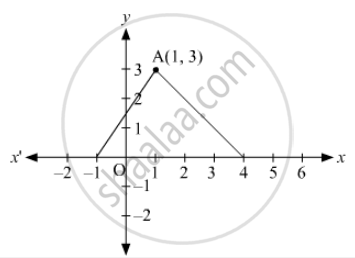Advertisements
Advertisements
प्रश्न
If the area of the triangle formed by the points (x, 2x), (−2, 6) and (3, 1) is 5 square units , then x =
पर्याय
- \[\frac{2}{3}\]
- \[\frac{3}{5}\]
3
5
उत्तर
We have the co-ordinates of the vertices of the triangle as A (x , 2x) ; B (-2 , 6) ; C ( 3 , 1) which has an area of 5 sq.units.
In general if `A (x_1 ,y_1 ) ; B (x_2 ,y_2) ; C (x_3 , y_3)` are non-collinear points then area of the triangle formed is given by-,
`"ar"(ΔABC ) = 1/2 |x_1(y_2 -y_3) + x_2 (y_3 - y_1 ) + x_3 (y_1 - y_2 )|`
So,
`5 = 1/2 |x(6-1)-2(1-2x)+3(2x - 6)|`
`5 = 1/2|15x - 20|`
Simplify the modulus function to get,
`3x - 4 = +-2`
`x = (4+-2)/3`
Therefore,
`x =2 , 2/3`
APPEARS IN
संबंधित प्रश्न
Prove that the points (3, 0), (6, 4) and (-1, 3) are the vertices of a right-angled isosceles triangle.
Find the coordinates of the point which divides the line segment joining (−1,3) and (4, −7) internally in the ratio 3 : 4
Three consecutive vertices of a parallelogram are (-2,-1), (1, 0) and (4, 3). Find the fourth vertex.
Prove that (4, 3), (6, 4) (5, 6) and (3, 5) are the angular points of a square.
Show that the following points are the vertices of a square:
(i) A (3,2), B(0,5), C(-3,2) and D(0,-1)
Show that the points A(6,1), B(8,2), C(9,4) and D(7,3) are the vertices of a rhombus. Find its area.
The midpoint P of the line segment joining points A(-10, 4) and B(-2, 0) lies on the line segment joining the points C(-9, -4) and D(-4, y). Find the ratio in which P divides CD. Also, find the value of y.
If the point A(0,2) is equidistant from the points B(3,p) and C(p, 5), find p.
Show that the points (−2, 3), (8, 3) and (6, 7) are the vertices of a right triangle ?
If the points P, Q(x, 7), R, S(6, y) in this order divide the line segment joining A(2, p) and B(7, 10) in 5 equal parts, find x, y and p.
Find the ratio in which the line segment joining the points A(3, −3) and B(−2, 7) is divided by the x-axis. Also, find the coordinates of the point of division.
If points Q and reflections of point P (−3, 4) in X and Y axes respectively, what is QR?
If the points (k, 2k), (3k, 3k) and (3, 1) are collinear, then k
If Points (1, 2) (−5, 6) and (a, −2) are collinear, then a =
In Fig. 14.46, the area of ΔABC (in square units) is

Abscissa of all the points on the x-axis is ______.
The point at which the two coordinate axes meet is called the ______.
The points whose abscissa and ordinate have different signs will lie in ______.
The point whose ordinate is 4 and which lies on y-axis is ______.
Seg AB is parallel to X-axis and coordinates of the point A are (1, 3), then the coordinates of the point B can be ______.
